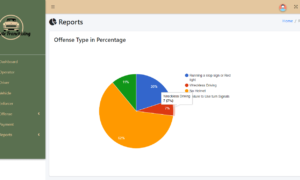Students’ Grade Record Profiling System Complete Capstone Documentation
Chapter 1
INTRODUCTION
Computers have changed the world and are here to stay. They have changed people lives not only in everything they do. But also they changed daily activities, and lot more. Computers are used as storage and management of data; they can serve as huge knowledge bases and can be harnessed for all sorts of transactions due to their processing power and storage capacities. As computers are a daily utility, they have gained immense importance in day-to-day life. Their increasing utility has made every business organization and educational institutions switch from paper-based to automated systems.
The move from paper-based record systems to automated systems, or the upgrade of existing automated systems, means that there is a greater chance that information will be readily available when important decisions must be made about improving educational services. A well-designed student record system ensures that data are readily available to manage the education system efficiently and to effectively meet the needs of students.
According to Gordon Schools the advantages of automated systems are the following: Speed, they can process information much more quickly than humans; Repetition – Automated systems can do the same task over and over again without getting bored, needing breaks or making mistakes; Accuracy, they can do very detailed work and follow precise instructions without error; and Efficiency, the quality of the work done is always of the same standard being materials are not wasted due to human error.
One of so many problems encountered by students is the time they spend in getting their grades in the Registrar Office. In front of the Registrar’s office, a crowd of student can be seen who are waiting for the release of their grades.
The record of every student and every course are handled manually and is purely paper-based. The office is currently not using a computer to record and process the releasing of grades. If the students want to see their school records, particularly their grades, the office staff will have to search and fetched for the records of the students one by one.
This process is very tedious and time consuming. The whole school is depending upon one man who maintains the student’s records. In this current system, data records are kept under file maintenance system. Due to this, the placement of the data is not at one particular place. This results in more consumption of time for the proper maintenance of records. Also, the system does not support any type of data integrity.
Registrar Office is using manual system in keeping grades of students. There are cases that some of the grades were lost or misplaced due to misfiling of student’s records. Sometimes students are making unusual actions like changing and getting grades without the concern of Registrar’s staff or even the teachers that is in charge of a particular subject.
There is no proper arrangement and procedure in issuing grades. It is also hard to the part of the students, they fall in line about a couple of minutes or an hour just to get their grades but the flow of issuance of grades is too slow. If they are still using the manual system the Registrar can’t give better service to the students.
In line with this, the researchers were challenged and developed a study on the development of a computerized record-keeping system, entitled “Studnets’ Grade Record Profiling System, that is accurate, fast, and accessible for the Registrar’s Office of OF THE SCHOOL.
SGRPS-OF THE SCHOOL would facilitate the record-keeping and issuance of grades. It will provide smooth operation purposes and it seeks for further advancement in the school system where technology can help the office to be more efficient. The SGRP system will automate the records of students and the process of grade issuance of the school. If the student’s records will be automated, the school will be able to increase staff efficiency, perform routine tasks automatically, and deliver their services more efficiently.
Objectives of the Study
The main purpose of this study was to develop an automated student record-keeping system that is accurate, fast, and accessible.
Specifically, this study aimed to:
- Minimize the manual system in record-keeping and issuance of student’s grades.
- Eliminate lag time between the submission of grades by subject teachers and the department head to the registrar, thus preventing a delay in submission and issuance of grades.
- Provide a system can be used by the faculty, department head, registrars’ personnel and staff.
- Develop a record services using database system in storing students grades.
Significance of the Study
This study is beneficial to the following:
School Administrators. The study will provide important information that will lead to school administrators in finding ways and means to increasingly rely upon computers and information technology to deliver their services and programmes more efficiently.
School Staff. Student’s retrieval of records can easily be accessed. The study will provide an improved method of processing the hundreds of grade reports and distribute them anytime the student needs it.
Faculty. This study will save the faculty effort and will lessen the time of recording the grades in grade sheets.
Students. This study will help lessen the late issuance of grades that can affect the students in many ways including approval of scholarships, delay of graduation, and others.
Researchers. This study will give the researchers a venue to further develop their programming skills. This study will also improve the research and thesis writing skills of the researchers.
Future Researchers. The result of this study will encourage other researchers to conduct further studies in automation to facilitate daily operations and planning in a records and archives of educational institutions.
Scope and Limitation of the Study
The study focused only in the issuance of grades in the Registrar’s office and the system offers more than just a class card function, and encoding of student’s grades. The system will lessen the work especially of those within the registrar’s office because the grades will be stored directly into a database.
The database maintenance focused on adding and deleting user accounts; maintaining and managing table entries of student records, user’s log, and monitoring of user’s activities in the system.
The developed system shall be installed in a central server located at the IT department and will have a back-up server that will serve as secondary storage in case of main server breakdown. The ARS system can be accessed by front-end users and back-end users through the school’s Intranet.
The SGRP system shall be limited to the front-end users such as the OF THE SCHOOL’s faculty, department head, registrars’ personnel and staff to access the system; and back-end user such as the system administrator. A user ID and password will be issued to authorized users in order to access their user account in the system.
The features of the system focused on log-in/log-out services, recordkeeping, database maintenance, and help assistant.
Chapter 2
RELATED LITERATURE AND STUDIES
This chapter presents the related literature and studies of the present study wherein researchers will acquire basic information that are necessary in the study.
Related Literature
Advantages of Automated System
The advantages of automated systems are the following: Speed – they can process information much more quickly than humans; Repetition – Automated systems can do the same task over and over again without getting bored, needing breaks or making mistakes; Accuracy – They can do very detailed work and follow precise instructions without error; and Efficiency – the quality of the work done is always of the same standard being materials are not wasted due to human error.
(http://www.Gordon schools.aberdeenshire.sch.uk/index.htm, October 5, 2010, 4:00pm)
Basic Requirements of an Electronic Recordkeeping System
An electronic recordkeeping system must be able to: collect, organize, and categorize records; and facilitate the preservation, retrieval, use, and disposition of records. On integrity, the system must ensure the integrity of the records it manages and be able to: minimize the risk of unauthorized alteration or erasure of the records, allow only authorized personnel access to the records in the system, allow only authorized personnel to perform administrative functions such as creating or deleting directories, altering the parameters of metadata fields, and assigning access rights. On retrieval of records, the system must retrieve records and be able to: permit easy retrieval in a timely fashion; ensure that records are accessible by individuals who have a business need for information in the records; provide a method for all authorized users of the system to retrieve desired documents, such as an indexing or text search system; and permit retrieval of both individual records and files or other groupings of related records.
(http://www.epa.gov/records/ tools/erks.htm, October 5, 2010, 4:00pm)
Related Studies
Benefits of a Well-Designed Studnets’ Grade Record Profiling System
A well-designed Studnets’ Grade Record Profiling System will reach more than teachers and administrators. It will also benefit the students, parents, community, legislators, and others by providing information on the functioning and success of the education system. The advantages of a Well-Design automated Record System are the following: Cost saving and cost avoidance- A well-conceived and implemented Studnets’ Grade Record Profiling System can reduce the costs of handling the paperwork associated with record keeping; Quicker Response- allows for timely retrieval of needed information; Accuracy- is vital at every stage, from data collection, to entry, to maintenance in the system it provides users with the confidence they will require to rely upon a student record system; Getting the needed information- they can provide the information required on request, easily, and without burdensome trial-and-error searching; Moving data among different education agencies- allows for the easy and efficient movement of student records among levels of the education system using standard formats.
(http://nces.ed.gov/pubs2000/building/benefits.asp, October 22, 2010, 3:00pm)
Records that provides Statistical Reports and Rosters
According to University of North Carolina (2010) the institution is using a Student Academic Information Datamart (SAID) it is a data mart storing historic student records from the Student Information System (SIS). The data mart is implemented to satisfy the growing needs for specific data and information about many different types of academic information. The Student Academic Information Datamart (SAID) has data up to Summer 2010 and new data will no longer be loaded. The ITS Student Data Warehouse will contain student enrollment data beginning in the Fall 2010, this database is totally controlled by ITS.
(http://regweb.oit.unc.edu/stats/said.php, October 23, 2010, 10:00am)
Student Records
The University of Wisconsin Madison Student Record main purpose was to ensure the following: established record keeping requirements, protect the University’s liability, provide institutional accountability, and safeguard the academic interests of students, to insure that records are retained for a sufficient period of time in order to meet administrative, audit, legal, research, and historical needs , to establish uniform retention and disposition of student records, to promote cost effective and efficient management of records and information, and to provide campus offices with the legal authorization to dispose of records on a routine basis. The creation, maintenance, retention and disposition of student academic information is a core function within higher educational institutions. Student records identify the academic institution’s official student body, document their progress through a course of study, show degrees and certifications earned, support applications to other institutions, support job applications, and frequently are referenced as historical records. Student records and record keeping supports and /or documents all the administrative activities relating to the admission, attendance, advising and counseling, completion of coursework and requirements, and ultimately graduation and the attainment of a degree.
(http://archives.library.wisc.edu/records/schedules/GRS_StudentRec.pdf, January 30, 2011)
Synthesis
The literatures and studies gathered and presented in this chapter gave the researchers insights, facts, and adequate information that will serve as the basis, guide, and reference that are relevant and necessary in the development of system. It also guides the researcher in making comparisons between his findings with the findings of other similar studies.
The concept on the advantages of automated systems such as speed, repetition, accuracy, and efficiency provide the researchers facts on automated systems and significance on the quality of the work done and efficiency in the work place which serves also as bases of the researchers on how to developed the software.
The Student Academic Information Datamart (SAID) is implemented to satisfy the growing needs for specific data and information about many different types of academic information. The developed student record system will also implement the use of a database that will store academic information such that locating, searching, and processing of records will be fast. However, the present study will only store student’s information and academic records particularly student grades.
The study on the benefits of a Well-Designed Studnets’ Grade Record Profiling System by nces.ed.gov had given the present study relevant information, particularly, on the benefits of a well-designed Studnets’ Grade Record Profiling System to students, parents, school administrators, and others.
These concepts, ideas, and studies are adopted by the researchers to support the study and to establish references that are important and necessary in the development of system.
Chapter 3
METHODOLOGY
This chapter presents the system methodology and software development approaches and techniques used in the conduct of the study.
System Development Method
On software development and implementation, the researchers used the System Development Life Cycle (SDLC) method in the development of the SGRP system. This method helped the researchers in conducting the study, analysis and design of the system. It is made up of several phases and the details of these are: Information Gathering, Analysis Phase, Design Phase, Development, Testing, and Delivery.
Information Gathering. In this phase, the existing system was evaluated and deficiencies were identified. This is done by interviewing users of the system and consulting with support personnel. Data were gathered from the respondents to determine their perception on the following: problems they experienced or encountered in the existing manual system of registrar system; the level of difficulties; the perception on the extent of need; and the features that should be included in the development of the system.
Respondents of the Study. The respondents of the study are the registrar staff, department chairman, faculty, and the students.
Table 1.0 showed the distribution of respondents according to their course and year level for the students, faculty and department chairman, and registrar staff.
Sampling Procedure and Technique. The researchers used the Slovin’s formula to determine the sample size of the students. Stratified random sampling technique was employed since the student respondents are classified according to their course and year levels, as well as, the faculty and the department chairman while the registrar staff is treated as total sample.
Data Gathering Instrument. The researchers have made use of SGRPS-OF THE SCHOOL Survey Questionnaire as an instrument to gather data from the respondents. Respondents of the study were the five (4) Registrar’s Personnel, fifteen (15) faculties, and 317 students of OF THE SCHOOL (Main Campus) who were officially enrolled in School Year 2010-2011. The sample questionnaire is shown in Appendix 1.
The questionnaire was composed of two (2) interrelated parts. These are:
The first part of the questionnaire was designed to determine the occupation of respondents for the purpose of grouping the respondents.
The second part of the questionnaire was subdivided into three (3) sub-sections, which were labeled with A, B and C.
Section A. This section was intended to determine the level of difficulty encountered by the respondents in the existing system. The respondents were instructed to choose among the five (5) alternative choices based on the 5-rating Likert Scale, such as: 5 for “extremely difficult”, 4 for “very difficult”, 3 for “moderately difficult”, 2 for “slightly difficult”, and 1 for “least difficult”.
Section B. This section was intended to measure the perception on the extent of need as perceived by the respondents in the development of SGRPS-OF THE SCHOOL. The respondents chose from five (5) choices based on the 5-rating Likert Scale, such as: 5 for “always needed”, 4 for “very often needed”, 3 for “sometimes needed”, 2 for “rarely needed”, and 1 for “never needed”.
Section C. This section was intended to determine the features that should be included in the development of SGRPS-OF THE SCHOOL by the use of check list method. The respondents were instructed to check in the box of the features that would be included in the system.
Data Gathering Procedure. The survey questionnaire was constructed by the researchers using two (2) methods: 5-rating Likert Scale method and Checklist Method.
Validity of the Questionnaire. In testing the validity of the questionnaire, the researchers consulted three (3) jurors. The questionnaire was subjected to face and content validation of the jurors. The content validity was based on the criteria set-forth by Garner V. Good and Douglas R. Scates as shown in Appendix 2.
The mean score obtained was interpreted as follows:
Score Range Interpretation
4.21 – 5.00 Excellent
3.61 – 4.20 Very Good
2.61 – 3.60 Good
1.81 – 2.60 Fair
1.00 – 1.80 Poor
After the questionnaire was presented to the jurors, the questionnaires were gathered and the jurors rating scores were tabulated. The over-all mean score was 4.3, which was descriptively interpreted as very good. Thus, the over-all score had indicated that the survey questionnaire was valid.
Data Processing and Statistical Treatment. After the tabulation of the survey results, the following statistical tools were used to interpret the collected data. For section A1, A2, and B, the arithmetic mean was used.
For section C, percentile ranking was employed. The top three (3) features were included in the development of the system. However, other features that the researchers perceived to be important were also included.
On Analysis Phase. In this phase, the researchers studied how the system will work, determine the user’s needs and requirements, and will recommend a solution. This also involves developing estimates for the work to be performed, and defining the plan to perform the work.
On Design Phase. On this phase, process modeling and data modeling was designed by the researchers. Context diagram and data flow diagrams was used to represent the flow of data in the system. Entity Relationship Diagram (ERD) was used as data model for the system.
On Development. The developed system was built in this phase. Activities performed by the researchers were the following: acquire necessary hardware and software, GUI designing, database design, coding, and integration of the modules.
On Testing. After the software was developed, the developed software was tested for potential errors and bugs. The system was evaluated by three (3) IT experts, the developed system was installed, and was made available for user for the user acceptance evaluation.
On Delivery and Maintenance. In this stage, the system is put into service so that the users can now start utilizing the system for their review.
The process framework used in developing the new system is presented in Figure 1.
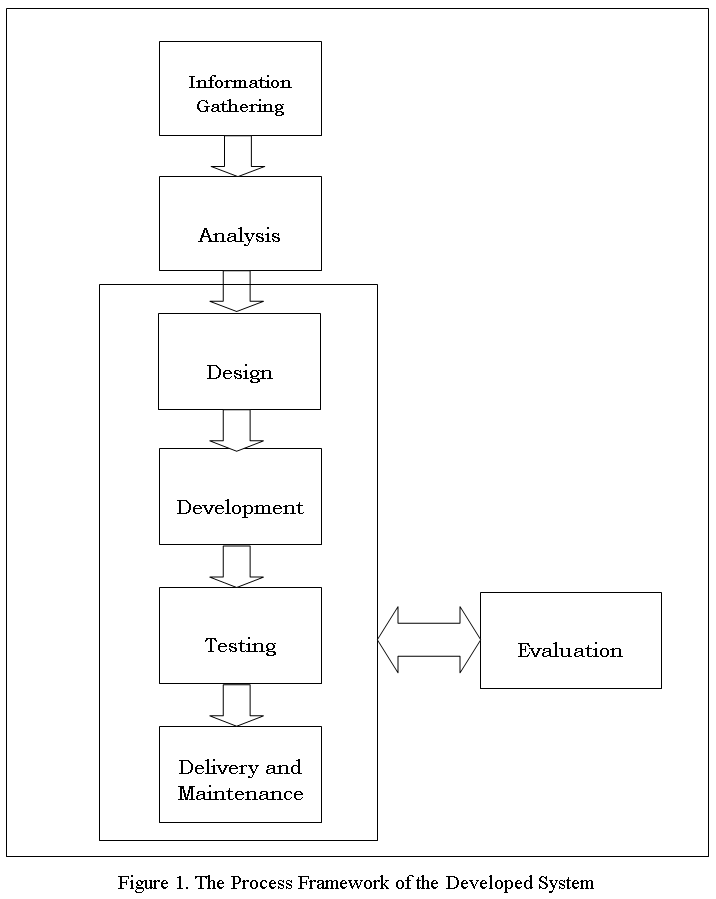
Software Development Procedure
The researchers present the software requirements, user requirements, hardware specifications, and people ware recommendations for the new system.
User Requirements. A self-made questionnaire was made by the researchers to determine user’s needs. The result revealed that the intended users of the new system experienced problems in the existing system of processing student’s grades, have strong extent of need of a system that will facilitate the record services of the school.
To minimize these problems, the researchers were able to identify the following user requirements:
- A login form that requires users to enter username and password to secure students records.
- A system that will provide relevant, accurate, and confidential student’s record.
- A system that will minimize the time consume in searching, retrieving, and preparing student record card.
System Requirements. This section presents the software requirements, hardware requirements, and peopleware requirements necessary for the development of the SGRP system. The researchers were able to gather information from the IT experts, searching from the Internet, and identified the existing equipments of the school. The researchers presents the minimum hardware requirements that are needed to fully utilized the SGRPS. The software requirements presented were the software used during the development of the system and also used in the documentation and in the presentation was recommended.
System Design
This portion describes the existing system, the developed system, screen forms and report layouts of the developed system.
The Existing System. The existing system of OF THE SCHOOL for processing and issuance of grades is paper-based and student grade report cannot be generated instantly. Documents are stored in folders and in filing cabinets. Storing of paper documents gets very voluminous.
The researchers present the context diagram and the decomposition diagram of the existing system which shows the procedures of each function, the users and the expected outputs of the existing system.
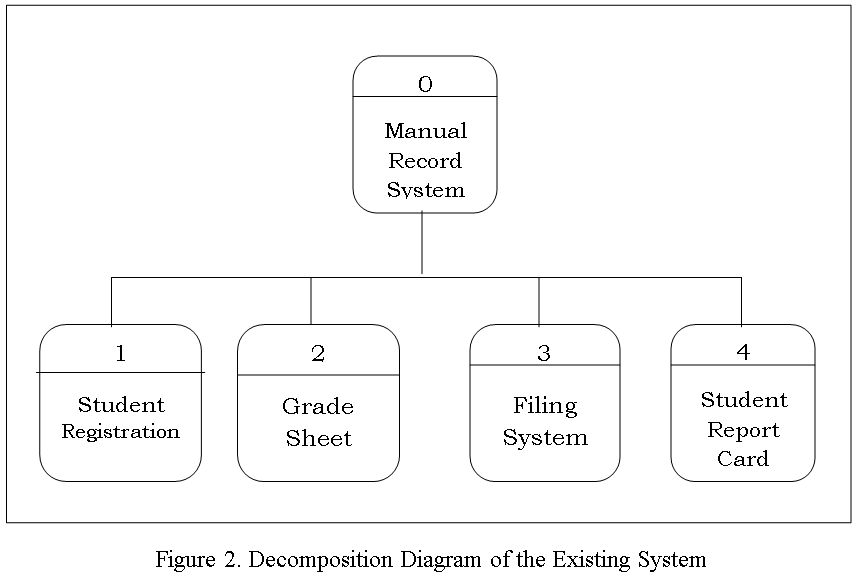
There are four (4) components in the existing system. These are the Student Registration Process; Grade Sheet Process, Filing System Process, and Student Report Card Process. These are presented in Figure 2.
On Student Registration – Upon enrolment to the school, students are required to fill in a student registration form to gather information from student such as personal data, addresses, and important information.
On Grade Sheet – After each term grade sheets are printed by the registrar’s office and are given to the teachers. The teachers will fill in the grade sheets, verify it, and submit it to the registrar’s office.
On Filing System – After the grade sheets are submitted to the registrar office, they are sorted according to semester, school year, and department and placed in folders.
On Student Report Card – The students will then present their prospectus and/or school ID to the registrar staff, the registrar staff will process the request by searching and locating the grade sheets submitted by the teachers and writes the grades in the student’s prospectus or student report card.
The researchers have observed that the need to automate the record keeping process of the registrar office will have a great impact in modernizing their facilities specifically in record keeping and grade issuance. Through the implementation of the developed system, they can be assured of an improved and systematic searching, recording, and releasing of student grades. Fast, accurate and reliable services will be offered to the community, accessible and relevant information for the Administrators.
The Developed System. This portion presents the context diagram, data flow diagram, database schema, and project dictionary of the developed software.
The SGRP system developed by the researchers will not only provide the institution a computer-based software but also to introduce the technology that will benefit not only the students and parents but also the school administrators.
The SGRPS offers several benefits, such as: reliable and complete information; easily accessible and accurate student record reports; high quality information; reduces errors in the result; produces output in greater quantities and of better quality; and provides an electronic tool that is user friendly and easy to use. The developed system also provides an information back-up to prevent computer crimes and file corruption.
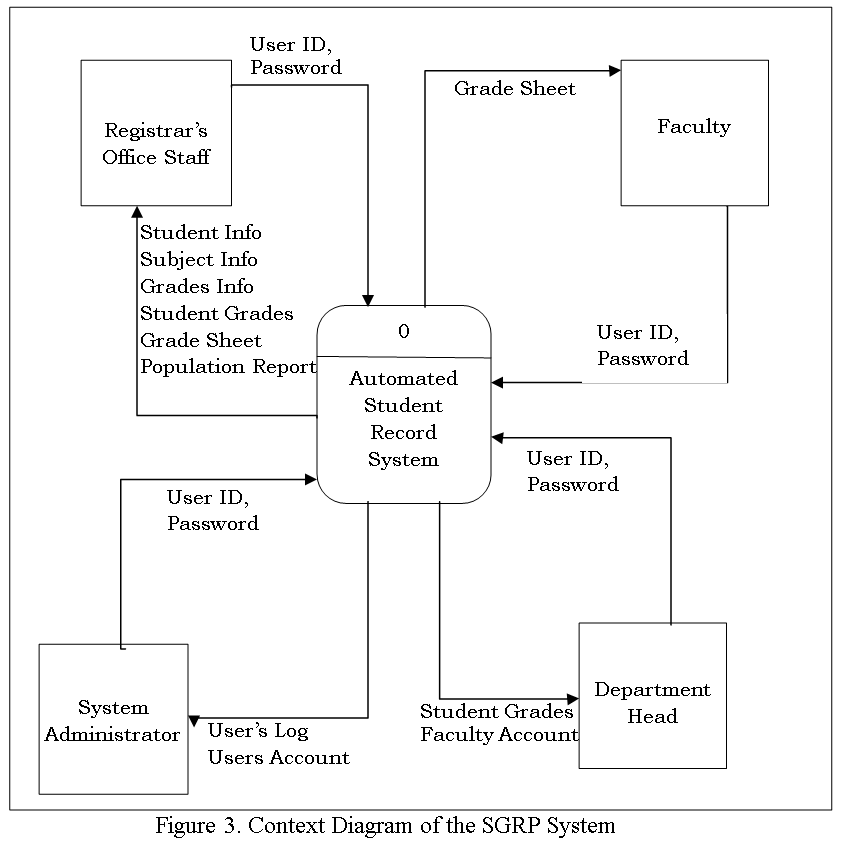
Figure 3 presents the context diagram of SGRPS-OF THE SCHOOL system which illustrates the user input to the system and the output information to the users. The users will need to enter their user id and password to be able to access the developed system. Users will be provided the following: Students Grades; Population Report; Grade Sheet; and Users Account.
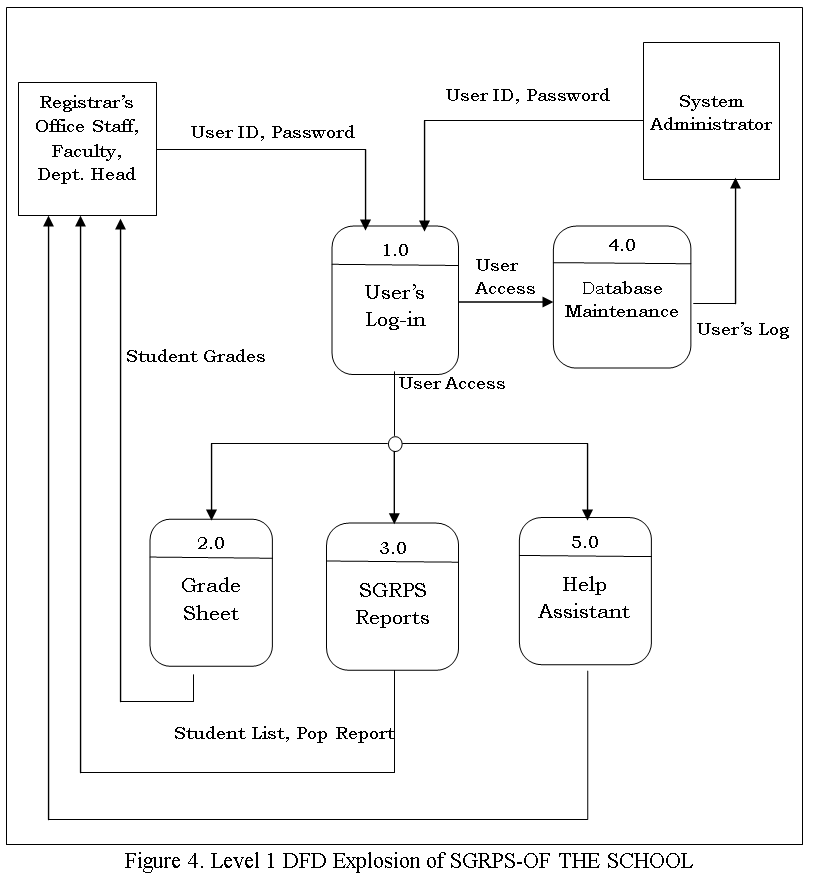
Figure 4 illustrates the process on how users can access the four modules namely: User’s Login Process, Student Profile Process, Student Grades Process, SGRP Reports Process, Database Maintenance Process, and Help Assistant Process.
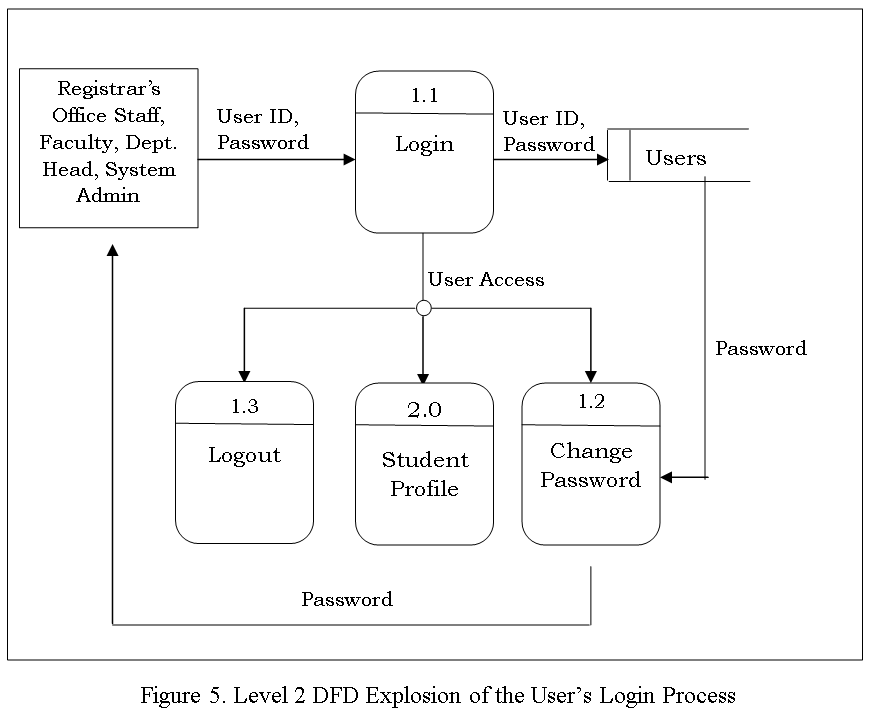
Figure 5 presents the Level 2 DFD Explosion of the User’s Login Process of SGRPS-OF THE SCHOOL. In order to access the system, user is required to enter their user ID and password. Upon successful login in the system, users can access the student profile process and other features of the system. Authorized users can also change their password.
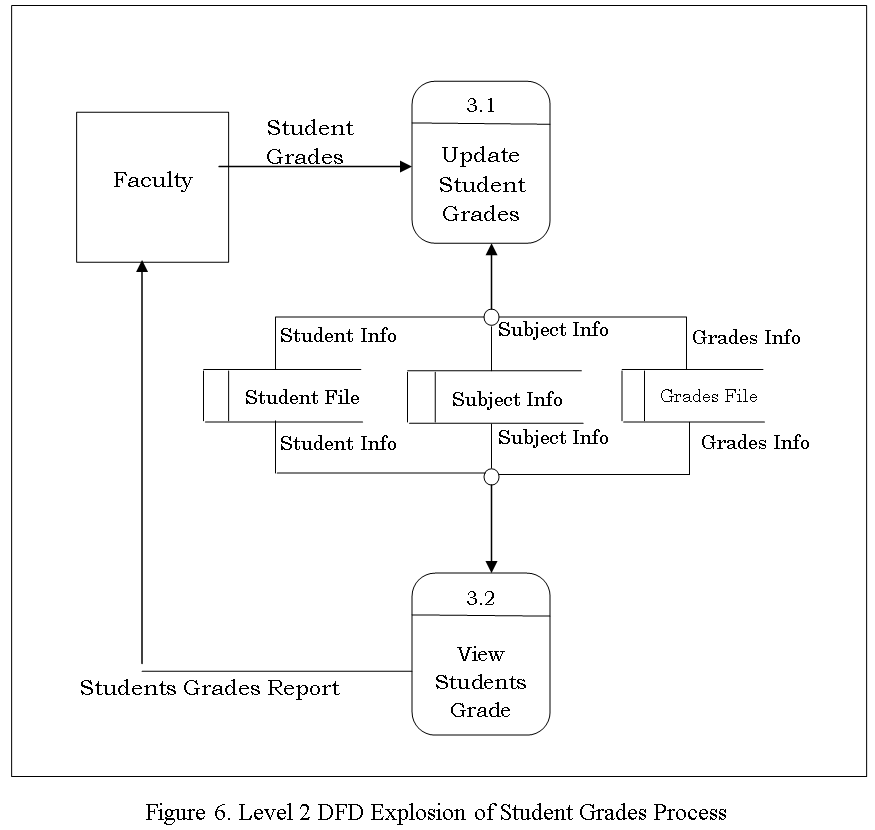
Figure 6 presents the level 2 DFD explosion of the student grades of SGRPS-OF THE SCHOOL. Faculty updates the student grades of students officially enrolled in their class. A Student Grade Report can be viewed by the Faculty after saving the changes made on student’s grades into the system.
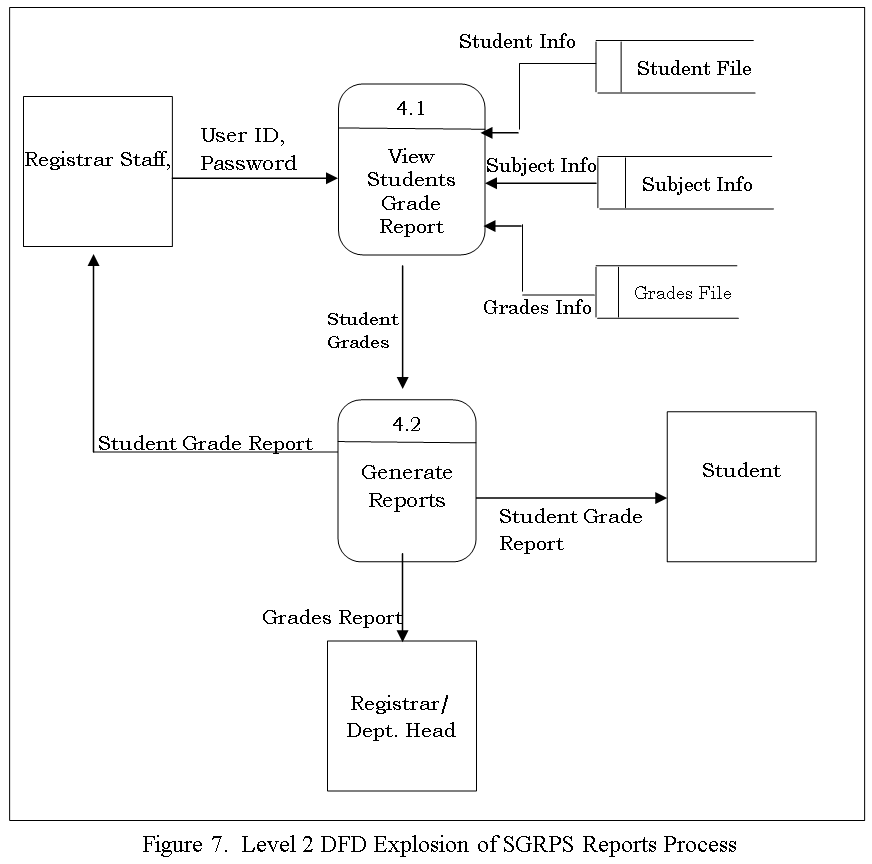
Figure 7 presents the Level 2 DFD explosion of the SGRPS Reports module of SGRPS-OF THE SCHOOL. Authorized users can view and will be provided a hard copy of student grade reports. The registrar’s office staff can print and release student grade report of each student.
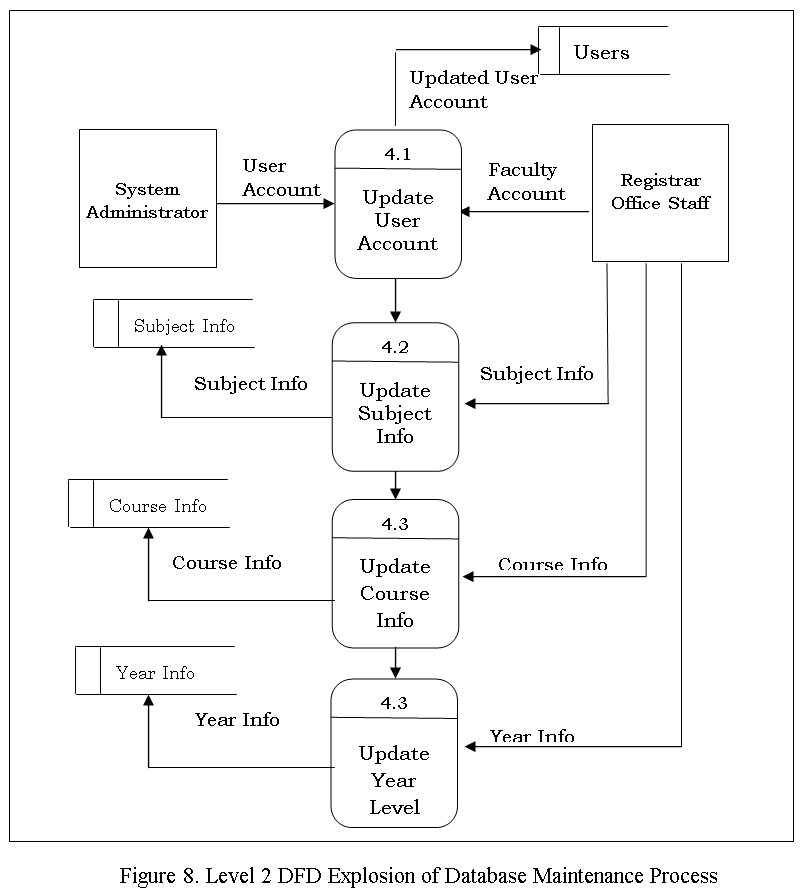
In the Level 2 DFD Explosion of Database Maintenance on Figure 8, the System admin and Registrar’s Office staff have access to this feature. The system admin can add, edit, and delete user’s account and is in-charge of backing-up the system. The Registrar’s Office staff can update subject information, course information, and year level information.
Database Schema. The researcher presents the database model by utilizing the Entity-Relationship (ER) Diagram. The SGRPS database stores details about the students, faculty, courses, the semester and the school year a student took a particular subject and his grade if he completed it, and what course and year level each student is enrolled in.
The researchers consider the following requirements list: the admin or dept. head provides system access to faculty; the admin manages the users of the system; the faculty is the one who gives grades to students of a particular subject offered during the semester (1st or 2nd) and school year; a student is enrolled in a course who belongs to a year level; a student must enroll in a subject; a subject has a subject code, subject name, and unit; a course has a course id, a course initial, and a course name; and the registrar releases the grades of the students on a subject.
The ER diagram derived from the requirements list is shown in Figure 9.
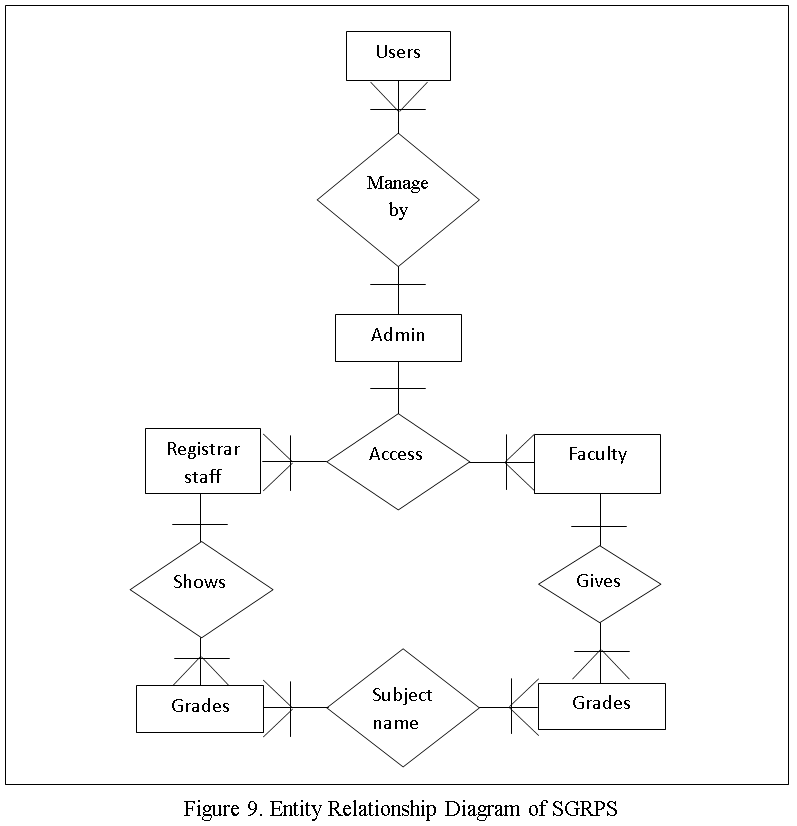
Network Architecture. The SGRPS shall be installed in the OF THE SCHOOL main server employing the star topology and adapts a Local area Network (LAN) connection specifically in the ICT Department. Hubs will be used for network connections. The hub is a device wherein many computers can connect to a server for sharing of data and information and it connects computers within the limited area only. A back-up server will be provided to assist the main server in-case the main server bug downs.
Authorized registrar’s office staff can utilize the SGRPS through the school’s Intranet. The developed system can be accessed by Faculty members in their respective departments where one (1) computer unit was installed.
Chapter IV
Results and Discussion
This chapter presents the system description, system implementation and mechanics, project management and cost analysis of the study.
System Description
The Studnets’ Grade Record Profiling System (SGRPS) is an automated system for the registrar’s office to update student’s profiles and fast and accurate release of student’s grades. The developed system can provide an accurate and fast releasing of grades to students. It also minimizes the tasks of the person in-charge in the releasing of grades and keeping the student’s record.
The target users of the developed system are the faculty, department chairman, registrar office personnel and system administrator.
This system provides a computerized student’s records and the registrar’s staff can print student’s population report, and student’s grades. The department chairman can also view student’s grades and the faculties subject load.
System Implementation and Mechanics
This section presents the decomposition chart of the software and discussion of each menu, sub-menus, its functions or purpose, and accessibility of the menu/sub-menu(s).
The researchers present the decomposition diagram of the developed system which shows the procedures of each function, the users and the expected outputs of the developed system.
The User’s Log-In Process will be designed to protect the system from unauthorized access. Authorized users are prompted to enter their user ID and password. This includes the back-end users and the front-end users. The back-end users are the system administrator and head of Registrar’s Office who have access on user accounts, and database maintenance. The front-end users are the registrar’s staff and teachers who have access to: student’s profile, grade sheets, and other features of the system.
The Grade Sheet Process will allow faculty to input student’s grades in the system.
The SGRPS Reports Process will allow authorized users of the system to print grade sheets, student grade record, population report, and users log report.
The Database Maintenance Process will allow the system administrator to manage data and backup the system.
The Help Assistant Process will be designed to assist the authorized users on how to use the different features of the SGRP system.
Menu and Submenu of SGRPS-OF THE SCHOOL. This portion presents the main menu and submenu of the developed system. The authorized users of the system are the following: Registrar, registrar personnel, department chairman, and faculty.
CHAPTER V
SUMMARY, CONCLUSION AND RECOMMENDATION
This chapter presents the summary, conclusion and recommendation based on the findings of the study.
Summary
After conducting the research, the data gathered which includes the research method used; the respondents, the research instrument and the statistical tool used were summarized. The findings of the study were also presented in this section.
The study deals with the development of an Studnets’ Grade Record Profiling System for the school. The objective of the study is to develop an Studnets’ Grade Record Profiling System to that is accurate, fast and accessible. The study aimed to: 1.) Minimize the manual system in record keeping and issuance of student’s grades. 2.) Eliminate the lag time between the submission of grades by the subject teachers and the department head to the registrar, thus preventing of delay in submission and issuance of grades. 3.) Provide a system that can be used by the faculty, department head and the registrar’s personnel. 4.) to develop a record services using database system in storing student grades. The study was conducted to assess the registrar keeping the records of the students, the current methods and processes used by the registrar in keeping the records of the students, and the problems encountered by the students, faculty, as well as, the registrar with regards to the need in securing student’s grades and grade reports from alteration or loss, issuance of grades at the end of the semester, and submitting error-free grades by the faculty.
This study aimed to help the registrar’s office to the problems in record keeping, issuance of grades to the students, and submitting on time and error-free grades of the faculty.
Descriptive survey method of research was used in this study and questionnaires were prepared for data gathering. The survey questionnaires were distributed to actual respondents.
The total respondents of the study were one thousand nine hundred forty seven (1,946) and the sample size is three hundred thirty two (332) was determined using the Slovin’s formula. The students were grouped by course and by year level. Stratified random sampling technique was utilized.
The developed system was evaluated by three technical experts. The evaluation was based on the criteria on System Evaluation Instrument by using the McCall’s Software Quality Model which determined the quality of the software being developed. The evaluators had given the software a rating of 4.17, which was descriptively interpreted as very good.
Final testing was conducted by intended users of the developed system. The user acceptance mean score is 4.37, which was interpreted as excellent. Therefore, the developed software passed as a good quality software and the objective of the researchers have been achieved that is to developed SGRPS-OF THE SCHOOL that is that is accurate, fast, and accessible.
Conclusion
The following conclusions were made after conducting a thorough investigation and gathering of data:
- The respondents of the study encountered a high degree of difficulty on the existing system, which is relevant to the researchers of the study. This indicates that the respondents experienced problems in securing students records, searching and retrieving student grades, the use of manual procedures by the Registrar’s Office in keeping the students record are not secured from alteration or loss, and the students encountered problems in requesting grades at the registrar’s office and as well as, the faculty in submitting error-free grade sheets.
- The extent of need of the respondents in the development of SGRPS-OF THE SCHOOL is very often needed which shows that the respondents needed the developed system in the record services and the development of SGRPS is highly recommended.
- Important features should be included in the development of the system such as login.logout, grade sheets, reports, database maintenance, and help assistant.
- Majority of the respondents prefer to change the current registrar system for accurate, fast, and accessible for the students, faculty, department chairman, and the registrar itself.
- The Studnets’ Grade Record Profiling System is the possible solution to the problems in grade issuance, securing student’s grades from alteration or loss, in submitting error-free grades sheets by the faculty, and to maintain relevant, accurate, and confidential student’s record.
- The use of Studnets’ Grade Record Profiling System was readily accepted by the respondents.
- The objective of the study had been achieved, that is to develop an Studnets’ Grade Record Profiling System for OF THE SCHOOL that is fast, accurate, and accessible.
Recommendations
Below are the researchers’ recommendations based on the findings and conclusions of the study.
- In order to attain accurate, fast, and accessible registrar system, the current manual system must be replaced by the automated one.
- The registrar staff, department chairman and the faculty should be trained on how to use the Studnets’ Grade Record Profiling System.
- In order to have an organized Student Record System the registrar should use an Studnets’ Grade Record Profiling System.
- In order to avoid log time in submission of grades by the faculty, problems in requesting student’s grades, and to secure grades from alteration or loss, the Studnets’ Grade Record Profiling System is highly recommended.
- The researchers also recommended the following research titles for further study:
- Online Student Record System for OF THE SCHOOL
- E-Class Record for OF THE SCHOOL
- SMS Student Grade Query System

